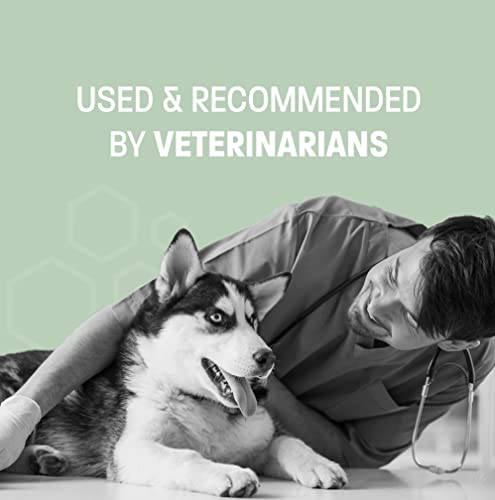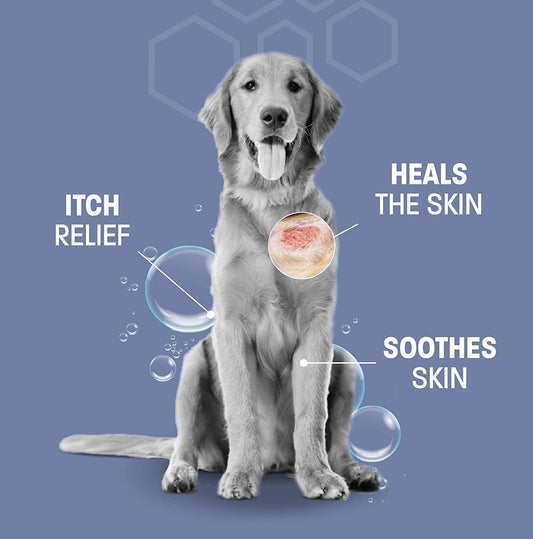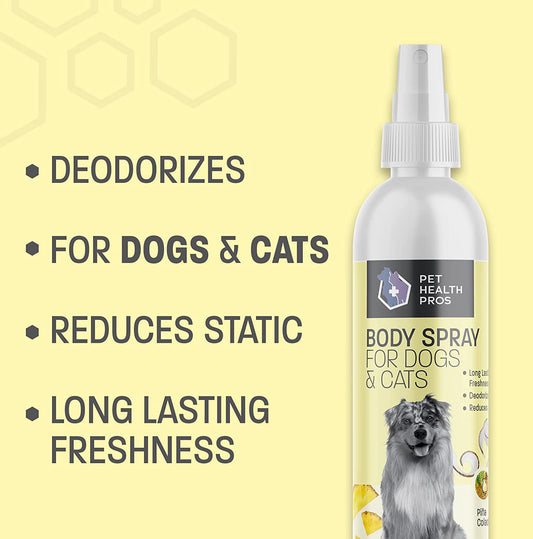Dog chewing can be a frustrating problem for many pet owners. Whether it's destructive chewing or excessive gnawing, understanding the reasons behind this behavior is crucial in finding an effective solution. In this article, we will explore the different types of chewing behavior, common triggers, and how to choose the right dog chewing repellent. We will also discuss training techniques and alternative solutions to discourage chewing. Finally, we will address persistent chewing issues and provide tips on seeking professional help and modifying the dog's environment.
Key Takeaways
- Understanding the reasons behind dog chewing behavior is essential in finding a solution.
- Boredom, teething, and separation anxiety are common triggers for excessive chewing.
- Choosing a dog chewing repellent requires considering factors such as safety and effectiveness.
- Positive reinforcement, creating a chew-friendly environment, and consistency are important in training.
- Providing appropriate chew toys, using bitter-tasting sprays, and supervising the dog can help discourage chewing.
Understanding Dog Chewing Behavior
Why do dogs chew?
Chewing is a natural behavior for dogs and serves several purposes. It helps to keep their teeth clean and healthy by removing plaque and tartar buildup. Chewing also provides mental stimulation and helps to relieve boredom. Additionally, puppies chew to soothe their teething discomfort. However, excessive chewing can be a sign of distress or anxiety and may indicate a behavioral problem that needs to be addressed.
Different types of chewing behavior
Understanding the different types of chewing behavior in dogs is essential for addressing excessive chewing. Dogs may engage in chewing for various reasons, including teething, boredom, anxiety, or even as a form of exploration. By identifying the specific type of chewing behavior exhibited by your dog, you can implement targeted strategies to address the underlying cause and redirect their chewing habits.
One way to categorize chewing behavior is by the objects or materials dogs prefer to chew on. Some dogs may have a preference for chewing on furniture, while others may target shoes or household items. Understanding your dog's chewing preferences can help you provide appropriate chew toys or redirect their chewing to more suitable items.
Another aspect to consider is the intensity of chewing. Some dogs may engage in gentle nibbling or mouthing, while others may exhibit more destructive chewing behavior. Recognizing the intensity of your dog's chewing can help you determine the level of intervention required.
It's important to note that excessive chewing can be a sign of underlying issues, such as separation anxiety or dental problems. If your dog's chewing behavior is persistent or causing harm, it's recommended to consult with a veterinarian or professional dog trainer for further guidance and support.
The importance of addressing excessive chewing
Excessive chewing in dogs can lead to a variety of problems, both for the dog and their owners. It is important to address this behavior as soon as possible to prevent damage to personal belongings, potential health issues, and to maintain a harmonious living environment.
One effective way to address excessive chewing is through positive reinforcement training. By rewarding desired behaviors and redirecting the dog's attention to appropriate chew toys, owners can teach their dogs what is acceptable to chew on and what is not. Consistency and patience are key in this training process.
Additionally, creating a chew-friendly environment can help discourage excessive chewing. Providing a variety of appropriate chew toys and ensuring they are easily accessible to the dog can redirect their chewing behavior away from household items. It is also important to remove any items that may be tempting for the dog to chew on, such as shoes or electrical cords.
In some cases, seeking professional help may be necessary to address persistent chewing issues. A professional dog trainer or behaviorist can assess the underlying causes of the chewing behavior and provide tailored solutions. They may also recommend modifications to the dog's environment or suggest addressing any underlying health problems that may be contributing to the behavior.
Remember, addressing excessive chewing is not only important for the well-being of the dog, but also for the overall happiness and harmony of the household.
Identifying Common Chewing Triggers
Boredom and lack of mental stimulation
Boredom and lack of mental stimulation are common triggers for dog chewing. Dogs are intelligent animals that require mental stimulation to keep them engaged and prevent boredom. When dogs are bored, they may resort to chewing as a way to alleviate their boredom and release pent-up energy. Providing your dog with plenty of mental stimulation can help reduce their desire to chew on inappropriate items.
One way to provide mental stimulation is through interactive toys and puzzles. These toys require the dog to think and problem-solve in order to access treats or toys hidden inside. This not only keeps them mentally engaged but also provides a positive outlet for their chewing behavior.
In addition to interactive toys, you can also engage your dog in activities such as obedience training, scent work, or agility exercises. These activities not only provide mental stimulation but also strengthen the bond between you and your dog.
Remember, a mentally stimulated dog is a happy and well-behaved dog!
Teething and oral discomfort
Teething is a natural process that puppies go through as their baby teeth are replaced by permanent adult teeth. During this time, puppies may experience oral discomfort and have a strong urge to chew. It is important to provide appropriate chew toys to help alleviate their discomfort and prevent them from chewing on inappropriate items.
Chew toys are specifically designed to soothe teething puppies' gums and provide them with a safe outlet for their chewing needs. These toys are made from materials that are gentle on their developing teeth and gums, such as rubber or nylon. It is important to choose chew toys that are the right size and texture for your puppy, as toys that are too small or too hard can pose a choking hazard or damage their teeth.
To ensure your puppy's safety, regularly inspect their chew toys for any signs of wear and tear, and replace them if necessary. Additionally, it is important to supervise your puppy while they are chewing to prevent any accidents or ingestion of small toy parts.
Separation anxiety and stress-related chewing
Separation anxiety and stress-related chewing are common issues faced by many dog owners. Dogs experiencing anxiety or stress will often turn to chewing as a way to comfort themselves. This behavior can be destructive and frustrating for owners, but it is important to understand the underlying causes and address them appropriately.
Choosing the Right Dog Chewing Repellent
Natural vs. chemical-based repellents
When it comes to choosing a dog chewing repellent, pet owners often wonder whether to opt for natural or chemical-based options. Both types of repellents have their pros and cons, and the choice ultimately depends on the individual dog and their specific needs.
Natural repellents are typically made from plant-based ingredients and are considered a safer and more environmentally friendly option. They often contain bitter-tasting substances that deter dogs from chewing on objects. Some popular natural repellents include bitter apple spray and citrus-based sprays.
On the other hand, chemical-based repellents are formulated with synthetic ingredients that are specifically designed to deter chewing behavior. These repellents often have a stronger and longer-lasting effect compared to natural options. They may contain substances such as denatonium benzoate, which is known for its extremely bitter taste.
When choosing between natural and chemical-based repellents, it's important to consider factors such as the dog's sensitivity, effectiveness, and safety. Some dogs may have allergies or sensitivities to certain ingredients, so it's crucial to carefully read the product labels and consult with a veterinarian if needed. Additionally, pet owners should prioritize the safety of their pets and choose repellents that are non-toxic and safe for use around the house.
In summary, both natural and chemical-based repellents can be effective in deterring chewing behavior in dogs. Pet owners should consider their dog's individual needs and preferences when selecting a repellent, and always prioritize their pet's safety and well-being.
Considerations for sensitive dogs
When choosing a dog chewing repellent for sensitive dogs, it is important to consider their unique needs and sensitivities. Sensitive dogs may have allergies or sensitivities to certain ingredients, so it is crucial to read the labels and check for any potential allergens. Additionally, opting for natural repellents can be a good choice for sensitive dogs as they are often gentler on the skin and less likely to cause irritation. It is also important to test the repellent on a small area of the dog's skin before applying it all over to ensure there are no adverse reactions. Lastly, consulting with a veterinarian can provide valuable guidance in choosing the right repellent for sensitive dogs.
Effectiveness and safety factors to look for
When choosing a dog chewing repellent, it is important to consider its effectiveness and safety. Effectiveness is crucial in ensuring that the repellent effectively deters the dog from chewing on unwanted items. Look for repellents that have been proven to be effective in preventing chewing behavior. Additionally, consider the safety of the repellent. It is recommended to choose repellents that are non-toxic and safe for dogs. Some repellents use natural ingredients, while others may contain strong chemicals that could be harmful, especially for sensitive dogs. Always read the labels and check for any potential risks or side effects.
Implementing Training Techniques to Stop Chewing
Positive reinforcement and redirection
Positive reinforcement and redirection are effective techniques for stopping dog chewing behavior. When you catch your dog chewing on something they shouldn't be, it's important to interrupt them in a gentle and non-threatening manner. You can use a verbal cue like 'Uh-Uh' or a noise like clapping your hands to get their attention. Once you have their attention, redirect their focus to an appropriate chew toy or bone. This helps to teach them what they are allowed to chew on and reinforces positive behavior. Consistency is key when using positive reinforcement and redirection. By consistently redirecting your dog's chewing behavior and providing them with appropriate alternatives, you can help them develop good chewing habits.
Creating a chew-friendly environment
Creating a chew-friendly environment is essential in preventing destructive chewing behavior in dogs. Here are some tips to create an environment that encourages appropriate chewing:
-
Provide plenty of appropriate chew toys for your dog to satisfy their natural urge to chew. Look for toys that are durable and designed specifically for chewing.
-
Keep valuable items out of your dog's reach. Store shoes, clothing, and other items that your dog may be tempted to chew in a secure location.
-
Use baby gates or crate training to limit your dog's access to certain areas of the house where they may be more prone to chewing.
-
Keep your dog mentally stimulated and engaged with interactive toys and puzzles. This can help prevent boredom and reduce the likelihood of destructive chewing.
-
Establish a consistent routine for your dog, including regular exercise and playtime. A tired dog is less likely to engage in destructive chewing.
-
Consider using bitter-tasting sprays or deterrents on items that your dog is prone to chewing. These products can help discourage chewing behavior.
-
Be patient and consistent in your training efforts. It may take time for your dog to learn what is appropriate to chew and what is not.
Consistency and patience in training
Consistency and patience are key when it comes to training your dog to stop chewing. It may take some time for your dog to understand what is expected of them, so it's important to be patient and consistent in your approach. Here are some tips to help you maintain consistency and patience in your training:
Alternative Solutions to Discourage Chewing
Providing appropriate chew toys
One of the most effective ways to redirect a dog's chewing behavior is by providing appropriate chew toys. Chew toys serve as a healthy outlet for a dog's natural chewing instincts and can help prevent them from chewing on inappropriate items. When choosing chew toys, it's important to consider the size, durability, and texture of the toy. Dogs have different preferences when it comes to chew toys, so it may take some trial and error to find the right one for your furry friend. Here are a few factors to keep in mind when selecting chew toys:
Using bitter-tasting sprays or deterrents
One effective method to discourage dogs from chewing on inappropriate items is by using bitter-tasting sprays or deterrents. These products are designed to have a strong and unpleasant taste that dogs find unappealing. When applied to objects that are frequently targeted for chewing, such as furniture or shoes, the bitter taste acts as a deterrent, discouraging the dog from continuing to chew.
Bitter-tasting sprays or deterrents are safe for dogs and do not cause any harm. They are typically made with natural ingredients that are non-toxic and harmless if ingested. However, it is important to follow the instructions provided by the manufacturer and avoid spraying the product directly on the dog's skin or eyes.
To use bitter-tasting sprays or deterrents effectively, it is recommended to:
- Thoroughly clean and dry the object before applying the spray.
- Apply the spray evenly and generously, ensuring that all surfaces are covered.
- Reapply the spray as needed, especially after cleaning or if the dog continues to show interest in chewing the object.
It is important to note that while bitter-tasting sprays or deterrents can be effective in preventing chewing behavior, they should be used in conjunction with other training techniques and environmental modifications to address the underlying causes of excessive chewing.
Supervision and management strategies
Supervision and management are crucial in preventing unwanted chewing behavior in dogs. By closely monitoring your dog and implementing effective management techniques, you can create a chew-friendly environment and reduce the chances of destructive chewing. Here are some strategies to consider:
- Provide appropriate chew toys: Offering a variety of chew toys can redirect your dog's chewing behavior onto acceptable items. Look for toys that are durable, safe, and designed for chewing.
- Use bitter-tasting sprays or deterrents: Applying bitter-tasting sprays or deterrents to objects that your dog is prone to chewing can discourage them from engaging in destructive behavior.
- Implement supervision and management: When you cannot directly supervise your dog, confine them to a safe area or use baby gates to limit access to certain rooms. This can prevent them from chewing on forbidden objects.
- Establish a consistent routine: Dogs thrive on routine, so providing them with a structured daily schedule can help reduce anxiety and boredom, which are common triggers for chewing.
Remember, consistency and patience are key when implementing these strategies. It may take time for your dog to learn appropriate chewing behavior, but with proper supervision and management, you can put an end to destructive chewing.
Dealing with Persistent Chewing Issues
Seeking professional help
If you have tried various training techniques and deterrents but your dog's chewing behavior persists, it may be time to seek professional help. A professional dog trainer or behaviorist can assess the underlying causes of your dog's chewing and provide tailored solutions. They can help identify any behavioral issues, such as separation anxiety or compulsive chewing, and develop a customized training plan to address them. Additionally, a veterinarian can rule out any underlying health problems that may be contributing to the chewing behavior. Remember, seeking professional help is not a sign of failure but rather a proactive step towards finding a solution for your dog's chewing problem.
Addressing underlying health problems
When dealing with persistent chewing issues in dogs, it is important to consider and address any underlying health problems that may be contributing to this behavior. Poor nutrition or a poor quality diet can sometimes lead to coprophagia, which is the tendency of some dogs to eat their own poop or other dogs' poop. This behavior can be a sign of malnourishment or digestive issues. It is essential to provide a balanced and nutritious diet to prevent coprophagia.
In addition to nutrition, dental problems can also contribute to excessive chewing. Dogs may chew on objects to alleviate oral discomfort caused by teething, gum disease, or tooth decay. Regular dental check-ups and proper dental care can help address these issues and reduce the need for excessive chewing.
If you suspect that your dog's chewing behavior is related to an underlying health problem, it is recommended to consult with a veterinarian. They can perform a thorough examination and provide appropriate treatment or management strategies to address the root cause of the chewing behavior.
Modifying the dog's environment
Modifying the dog's environment is an important step in preventing excessive chewing behavior. By making a few changes to your dog's surroundings, you can create a more chew-friendly environment and reduce the likelihood of destructive chewing.
One effective strategy is to provide your dog with plenty of appropriate chew toys. These toys should be durable, safe, and specifically designed for chewing. By offering your dog a variety of toys to chew on, you can redirect their chewing behavior away from your belongings.
Another way to modify the dog's environment is to use bitter-tasting sprays or deterrents on items that you don't want your dog to chew. These sprays have a strong, unpleasant taste that can discourage your dog from chewing on furniture, shoes, or other household items.
Supervision and management are also key components of modifying the dog's environment. When you can't directly supervise your dog, it's important to confine them to a safe area or use baby gates to restrict access to certain rooms. This can help prevent them from engaging in destructive chewing when you're not able to intervene.
Conclusion
In conclusion, finding an effective dog chewing repellent is essential for maintaining a harmonious home environment. By understanding the reasons behind your dog's chewing behavior and implementing the right strategies, you can prevent damage to your belongings and ensure your dog's safety. Remember to consistently apply the chosen repellent and provide alternative chewing options to redirect their behavior. With patience and consistency, you can put an end to chewing and enjoy a peaceful coexistence with your furry friend.
Frequently Asked Questions
How can I tell if my dog is chewing excessively?
Excessive chewing can be identified if your dog is consistently chewing on inappropriate objects, causing damage to furniture, or showing signs of oral discomfort.
Are natural dog chewing repellents safe?
Yes, natural dog chewing repellents are generally safe as they are made from non-toxic ingredients. However, it is important to carefully read and follow the instructions provided by the manufacturer.
Can I use bitter-tasting sprays on all types of objects?
Bitter-tasting sprays can be used on most objects, but it is advisable to test them on a small, inconspicuous area first to ensure that they do not cause any damage or discoloration.
How long does it take to train a dog to stop chewing?
The time it takes to train a dog to stop chewing varies depending on the individual dog and the consistency of training. It can take anywhere from a few weeks to several months to see significant improvement.
What should I do if my dog continues to chew despite using repellents?
If your dog continues to chew despite using repellents, it is important to reassess the effectiveness of the repellent and consider seeking professional help to address any underlying behavioral issues.
Can separation anxiety be a cause of excessive chewing?
Yes, separation anxiety can be a cause of excessive chewing. Dogs with separation anxiety may engage in destructive chewing as a way to cope with their anxiety and alleviate stress.









